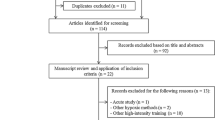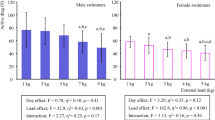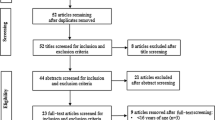Abstract
The purpose of this study was to investigate the effect of active or passive recovery after two different rest intervals on performance during repeated bouts of maximal swimming exercise. Sixteen swimmers (eight males and eight females) performed four trials in a counterbalanced order. Eight repetitions of 25-m sprints (8×25 m), with a rest interval of 45 or 120 s, followed by a 50-m sprint test 6 min later, were performed in each trial. The 45 or 120-s interval was either active (A45 and A120) or passive (P45 and P120). The intensity of the active recovery corresponded to 60% of the individual best 100-m velocity. Performance time was recorded using an official competition timing system. The first 25-m sprint was comparable across trials (P>0.05), but performance was decreased after the second sprint during active compared to passive recovery, irrespective of the interval duration (P<0.05). The 50-m sprint time was 2.4% better in the P120 and A120 compared to the A45 and P45 trials (P<0.05). After completing the 8×25 m, blood lactate was decreased with active recovery when the interval period was 120 s (P120 vs A120, P<0.05). Blood lactate concentration at the start as well as 5 min after the 50-m sprint was lower in the A120 and A45 compared to the P120 and P45 trials respectively (P<0.05). Plasma glycerol was not different between trials (P>0.05), whereas plasma ammonia was higher in the A45 compared to the P120 trial (P<0.05). The interval period separating short-duration sprints may therefore alter performance when subsequent maximum exertion is applied. For sustained sprinting ability, passive recovery is advised during repeated swimming sprints of short duration.


Similar content being viewed by others
References
Ahmaidi S, Granier P, Taoutaou Z, Mercier J, Dubouchaud H, Prefaut C (1996) Effects of active recovery on plasma lactate and anaerobic power following repeated intensive exercise. Med Sci Sports Exerc 28(4):450–456
Balsom P, Seger J, Sjodin B, Ekblom B (1992a) Physiological responses to maximal intensity intermittent exercise. Eur J Appl Physiol 65:144–149
Balsom P, Seger J, Sjodin B, Ekblom B(1992b) Maximal-intensity intermittent exercise: effect of recovery duration. Int J Sports Med 13(7):528–533
Balsom P, Gaitanos G, Ekblom B, Sjodin B(1994) Reduced oxygen availability during high intensity intermittent exercise impairs performance. Acta Physiol Scand 152:279–285
Bangsbo J, Graham T, Johansen L, Saltin B(1994) Muscle lactate metabolism in recovery from intense exhaustive exercise: impact of light exercise. J Appl Physiol 77(4):1890–1895
Bogdanis GC, Nevill M, Boobis L, Lakomy H, Nevill A (1995) Recovery of power output and muscle metabolites following 30 s of maximal sprint cycling in man. J Physiol (Lond) 482(2):467–480
Bogdanis GC, Nevill ME, Boobis LH, Lakomy HKA (1996a) Contribution of phosphocreatine and aerobic metabolism to energy supply during repeated sprint exercise. J Appl Physiol 80(3):876–884
Bogdanis GC, Nevill ME, Lakomy H, Graham C, Louis G(1996b) Effects of active recovery on power output during repeated maximal sprint cycling. Eur J Appl Physiol 74:461–469
Bogdanis GC, Nevill ME, Lakomy HKA, Boobis LH (1998) Power output and muscle metabolism during and following recovery from 10 and 20 s of maximal sprint exercise in humans. Acta Physiol Scand 163:261–272
Cazorla G, Dufort C, Cervetti J (1983) The influence of active recovery on blood lactate disappearance after supramaximal swimming. In: Hollander P, Huijing P, de Groot G (eds) Biomechanics and medicine in swimming. International series on sport sciences, vol 14. Human Kinetics, Champaign, Ill., pp 244–250
Dawson B, Goodman C, Lawrence S, Preen D, Polglaze T, Fitzimons M, Fournier P (1997) Muscle phosphocreatine repletion following single and repeated short sprint efforts. Scand J Med Sci Sports 7(4):206–213
Dill D, Costill D (1974) Calculation of percentage changes in volumes of blood, plasma, and red cells in dehydration. J Appl Physiol 37(2):247–248
Dupont G, Blondel N, Berthoin S (2003) Performance for short intermittent runs: active vs passive recovery. Eur J Appl Physiol 89:548–554
Dupont G, Moalla W, Guinhouya C, Ahmaidi A, Berthoin S (2004) Passive versus active recovery during high-intensity intermittent exercises. Med Sci Sports Exerc 36:302–308
Felix S, Manow T, Jarviw A, Jensen B, Headley S (1997) Swimming performance following different recovery protocols in female collegiate swimmers. J Swim Res 12:1–6
Gaitanos G, Williams C, Boobis L, Brooks S (1993) Human muscle metabolism during intermittent maximal exercise. J Appl Physiol 75(2):712–719
Gladden LB (2004) Lactate metabolism: a new paradigm for the third millenium. J Physiol (Lond) 558:5–30
Hargreaves M, McKenna M, Jenkins D, Warmington S, Li J, Snow R, Febbraio M (1998) Muscle metabolites and performance during high-intensity intermittent exercise. J Appl Physiol 84:1687–1691
Haseler L, Hogan M, Richardson R (1999) Skeletal muscle phosphocreatine recovery in exercise-trained humans is dependent on O2 availability. J Appl Physiol 86(6):2013–2018
Hermansen L (1981) Effect of metabolic changes on force generation in skeletal muscle during maximal exercise. Ciba Foundation Symposium, Human muscle fatigue: physiological mechanisms. Pitman Medical, London, pp 75–82
Holmyard D, Cheetham M, Lakomy H, Williams C (1987) Effect of recovery duration on performance during multiple treadmill sprints. In: Reilly T, Lees A, Davids K, Murphy W (eds) Science and football. Spon, New York, pp 134–142
Maglischo E (2003) Swimming fastest. Human Kinetics, Champaign, Ill.
McMahon S, Jenkins D (2002) Factors affecting the rate of phosphocreatine resynthesis following intense exercise. Sports Med 32(12):761–784
McMurray R (1969) Effects of body position and immersion on recovery after swimming exercise. Res Q 40(4):738–742
Peyrebrune M, Nevill M, Donaldson F, Cosford D (1998) Effects of oral creatine supplementation on performance in single and repeated sprint swimming. J Sports Sci 16:271–279
Sahlin K, Harris R, Hultman E (1979) Resynthesis of creatine phosphate in human muscle after exercise in relation to intramuscular pH and availability of oxygen. Scand J Clin Lab Invest 39:551–558
Signorile J F, Ingalls C, Tremblay L (1993) The effects of active and passive recovery on short-term high intensity power output. Can J Appl Physiol 18(1):31–42
Spriet L, Lindiger M, McKelvie R, Heigenhauser G, Jones N (1989) Muscle glycogenolysis and H+ concentration during maximal intermittent cycling. J Appl Physiol 66(1):8–13
Toubekis A, Tokmakidis S (2003) Active recovery decreases performance during repeated bouts of sprint swimming irrespective of resting interval duration. In: Chatard JC (ed) Biomechanics and medicine in swimming IX. Publications de l’ Université de Saint-Étienne, Saint-Étienne, France, pp 469–474
Weltman A, Stamford BA, Moffatt RJ, Katch LV (1977) Exercise recovery, lactate removal, and subsequent high intensity exercise performance. Res Q 48(4):787–796
Weltman A, Stamford BA, Fulco C (1979) Recovery from maximal exercise: lactate disappearance and subsequent performance. J Appl Physiol 47(4):677–682
Westerblad H, Allen D (2003) Cellular mechanisms of skeletal muscle fatigue. Adv Exp Med Biol 538:563–570
Yamamoto Y, Mutoh Y, Kobayashi H, Miyashita M (1987) Effects of reduced frequency breathing on arterial hypoxemia during exercise. EurJ Appl Physiol 56:522–527
Author information
Authors and Affiliations
Corresponding author
Rights and permissions
About this article
Cite this article
Toubekis, A.G., Douda, H.T. & Tokmakidis, S.P. Influence of different rest intervals during active or passive recovery on repeated sprint swimming performance. Eur J Appl Physiol 93, 694–700 (2005). https://doi.org/10.1007/s00421-004-1244-9
Accepted:
Published:
Issue Date:
DOI: https://doi.org/10.1007/s00421-004-1244-9




